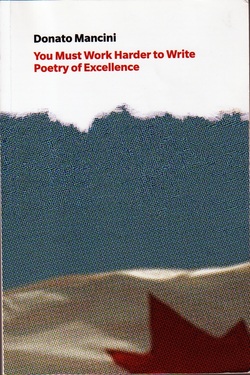
The numerous punctuation and spelling errors (including the misspelling of Victorian poet A.E. Housman’s name several times) should not greatly trouble a reader, but they do index a persistent editorial indifference that extends to the book’s structural awkwardnesses – such as its abrupt shifts of vocabulary and implied audience, and its odd chapter-long discussions of poems by Bob Perelman and Yevgeny Yevtushenko where readers have been led to expect a focus on Canadian poetry and the ideologies of its reviewers. References generally to Canadian poems or reviews are in fact disappointingly few in most of the first nineteen short unnumbered chapters of this thirty-seven chapter book, despite the wonderfully entertaining analysis of a J.R. Colombo review with which the book begins.
Mancini has several strong arguments, the central one being that most contemporary Canadian poetry reviewers appear intellectually and ideologically equipped to read and discuss only poetry based on pre-World War 2 Anglo-American poetics. They prefer such poetry, and they lament its
Mancini makes this argument with both wit and utterly convincing evidence, as when he amusingly unpacks the gender and class assumptions of David Solway’s defence of poetry’s “intelligent middlebrow reader” (128). But he does this mostly in the second 120 pages of his book, following eight chapters of theory that would likely baffle or exasperate most of the reviewers he critiquing. Many readers, I suspect, will be also baffled – if not stopped in their tracks – and be unable to connect his discussions of Kant, Hegel, Schiller, Zizek, contemporary Developmental Psychology and “aesthetic conscience” to the reviewers’ practices. Mancini does little here to help them – little to signpost the relevance of his theory chapters, or to address the effects of the abrupt shifts in reference and discourse that they bring.
Mancini also argues early in his book that Canadian reviewing practices resemble what Charles Bernstein has identified in the US as a pernicious “official verse culture” (12). His later analyses, particularly those in his eighteenth chapter, create some implicit contrasts between the verse culture (or “ideolect,” Mancini’s usual term) of those Canadian reviewers and the US one theorized by Bernstein, but he never specifically juxtaposes the two or comments on their differing national imperatives. A more systematic account of the values of a Canadian “official verse culture” (if indeed he believes there is one) than the list he identifies as “normally used to construct value for [John] Newlove’s work – Essential Canadianness, Individual Voice, the Human, Accessibility, Depth, Craft etc.” (125), together with some evidence of its ‘officialness,’ would have been helpful. He suggests as well that one of the causes of such formulaic reviewing in both countries is the lack of a resonant name for post-World War 2 poetics – that the various names it has received such as ‘avant garde,’ ‘experimental,’ ‘projective,’ ‘innovative,’ ‘research,’ ‘language-centered,’ ‘vanguard,’or ‘radical’ are each arguably limited or flawed, and easy to attack. He proposes that all should be known as “postmodern” because this term is more periodizing than polemic, and is aesthetically inclusive. The proposal makes sense to me, and will likely indeed become common practice – in five or ten decades. (Question: why has no one yet undertaken to edit or produce a Canadian anthology of postmodern poetry similar to the Norton one of postmodern American?)
But I don’t agree with Mancini’s characterization of conventional moralistic reviewing as the current Canadian dominant – I think it is more likely residual (as the Victorian was in the Canadian modernist period) and that his “postmodern” will eventually be seen to have been the present-day dominant. That is, I prefer Raymond Williams’ residual-dominant-emergent model of cultural change to the pervasively binary “two broad territories or camps” (17) model that Mancini adopts here while also unconvincingly arguing that, because this is not a “sealed binary,” and contains “multiply relative” positions (18), it is not a real binary. Well, there are also numerous species of duck, and almost all of them quack.
One realization the book caused for me was of how fractured the Canadian poetry scene must be. I had never noticed that many of the convention-upholding reviewers whose work Mancini interrogates – Burt Almon, Bert Archer, Derik Badman, Michelle Berry, Stephanie Bolster, David Carpenter, Weyman Chan, Dennis Crawley, Leona Gom, Alex Good, Katia Grubisic, John Lent, Andrew Lesk, Nathaniel Moore, Lyle Neff, Norbert Reubsaat, Bruce Serafin, Carmine Starnino, Jan Zwicky – were writing book reviews, and in many cases could not remember having seen their names. I follow a number of Canadian literary magazines and websites, but evidently not the ones in which they publish. In turn their reading paths seem not to have crossed with my publications.
Mancini’s book received a strange review from Alan Reed on the Lemon Hound website (http://lemonhound.com/2012/11/23/donato-mancinis-you-must-work-harder-to-write-poetry-of-excellence/). I couldn’t decide whether Reed was pretending not to understand Mancini’s arguments or genuinely misunderstood them – a possibility, considering the book’s awkward structure. One does have to work hard to read it. The review received 29 followup posts from 8 different writers – posts that often were repetitive and misunderstood the other responders as well as the book. Alas, this overall response may have been a signal of the book’s limitations in communicating with even a mostly (except perhaps for Reed) friendly audience. That would be quite unfortunate.
FD
 RSS Feed
RSS Feed